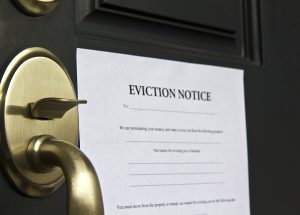Residential Eviction
 Utah law is very protective of people’s homes. For this reason the eviction process requires exactness to ensure someone is not wrongly removed from their home.
Utah law is very protective of people’s homes. For this reason the eviction process requires exactness to ensure someone is not wrongly removed from their home.
The eviction process begins by serving a notice, either to quit some violation of the law or lease, or to simply end the tenancy at the conclusion of the lease. If the notice is to quit the tenant will have an opportunity to correct the violation within a certain number of days (usually three).
If the tenant does not fix the problem or vacate the property, the landlord must file and serve a Complaint for Eviction. From there, the tenant will have three business days to file an Answer if he wishes to dispute the allegation in the Complaint. If the tenant does not file, the landlord may take default and request an Order of Restitution to retake the property.
If the tenant files an Answer, a possession hearing should be held within 10 days to address the issue of whether the eviction is proper. If the judge determines the tenant is right, he will be able to maintain the property under the terms of the lease. If the judge determines the landlord is right, an Order of Restitution will be issued.
An Order of Restitution generally gives the tenant three days to move from the property. If the tenant does not move, the landlord may then seek the help of local law enforcement to physically remove the tenant.
After the tenant moves or is removed, the landlord has an opportunity to inspect the property for damage. If there is damage or if the landlord is owed rent, he may request a damages hearing to seek a judgment for up to three times the amount of damages and rent that could have been collected during the eviction process.
If the tenant has left any personal property in the home, the landlord may move and store the property. The landlord must then send notice to the tenant’s last known address stating that the tenant may reclaim the property within 15 days for the cost of moving and storage. If the tenant does not pay these costs within 15 days, the landlord may dispose of the property as he sees fit.
Abandonment
A tenant has legally abandoned the leased property if he has not paid rent and is absent from the property without any contact for a period of 15 days. After this time, the landlord may lawfully take back the property without any judicial intervention.
Unlawful Eviction
A landlord has committed forcible detainer or entry (unlawful or wrongful eviction) if he has retaken the property by force (without a court order) or has retaken the property while the tenant was absent and refuses to surrender the property back to the tenant for a period of three days after the tenant makes such a demand.
If the landlord has committed forcible detainer or entry the tenant may file a lawsuit for wrongful eviction and may be awarded triple damages.
Constructive Eviction
Every lease agreement in Utah automatically includes a warranty of habitability. This means the leased property must be suitable for human inhabitance. If a problem arises that makes the property unsuitable for living, the tenant has a right to demand the problem be fixed. The type of problem will determine how much time the landlord has to fix it or start to fix it. Generally 24 hours for more serious problems. If the problem is not fixed in the appropriate amount of time, the tenant has three options: he can declare the lease breached and move from the property, he can fix the problem himself and deduct the cost from rent, or he can stop paying rent until the landlord fixes the problem.
Before the tenant choses any of these remedies, however, it is crucial that he first send a written notice to the landlord explaining his intent and the reason. A tenant cannot simply move or stop paying rent.
See Utah Fit Premises Act for more detail.